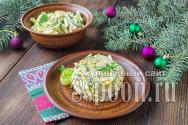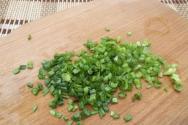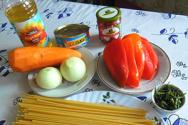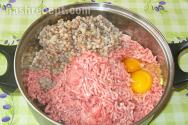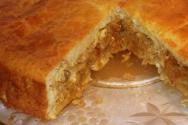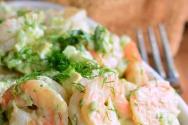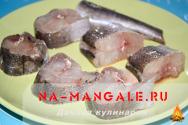Sugar lace at home. Decorating cakes with icing. The process of preparing elastic mass
Today it is very difficult to find a person who does not like sweet desserts, such as cakes. There are a large number of such recipes in cooking; they can be decorated with various patterns, inscriptions or icing. Probably not everyone knows what it is. Let's try to figure this out. So, translated from English, this term means “ice pattern.” And this is not surprising, since products made from it are similar to ice (in color and consistency). Icing, the recipe for which we will definitely learn today, makes it possible to create extraordinary decorations not only for desserts, but also for various dishes. Properly made, it has a matte finish and enormous strength. So, let's try to understand this issue in more detail.
What is "icing"?
Icing is a plastic thick mass of sugar and proteins used to create confectionery decorations that have volume. Usually this mass is white, but with the help of food coloring it can be given any shade. Icing, the recipe for which will be given below, is made by rubbing powdered sugar with fresh egg white. Lemon juice or acid, glucose syrup, glycerin, etc. are added to this mixture.
Working with icing
To work with flexible mass, pre-prepared templates are required, for example, drawings on paper or ready-made contours. Place cling film on such a drawing or place it in a file. In this case, it is not recommended to use parchment or tracing paper, since the icing sticks very strongly to them and then does not come off. So, the film is lubricated with a layer of olive oil (this is important!). Fresh protein mass is placed in a pastry envelope or syringe. At the same time, it should not be liquid so that it does not spread along the contours of the picture. A thick mixture, on the contrary, will be difficult to squeeze out of the envelope. However, in this case, you can sculpt from it in the same way as plasticine.

All elements of the drawing should not be thick. If you want to get multi-colored icing, the recipe for which is very simple, add food coloring to the mixture. You can also apply the mixture to the finished cooled confectionery product, for example, cookies or gingerbread, chocolate glaze. Do not apply it to biscuits or other non-dry surfaces. Only finished icing decorations are placed on them before serving. So, the film with a pattern is dried for about three days. Then the jewelry is carefully removed.

Openwork icing decorations
In this case, a mass of protein and sugar, that is, icing, the recipe for which is attached, is placed on small balloons; they must first be inflated and lubricated with oil. After the pattern has dried, the ball is simply deflated and removed from the product. This must be done carefully, as the resulting products are very fragile. It is recommended to make them with a small margin. A broken part can be glued using egg white mixed with powdered sugar. Store such jewelry at room temperature in a box. Let's take a closer look at the homemade icing recipe.
Icing heart
Ingredients: twenty grams of egg white, one hundred and fifty grams of powdered sugar, fifteen drops of lemon juice, red food coloring, vegetable oil, file and heart template.

Preparing icing
The whites are gently mixed, but not beaten. Add powder gradually, without ceasing to stir, add lemon juice with red food coloring dissolved in it. Mix everything thoroughly until the color becomes uniform. The mass is transferred to a pastry envelope or bag with a nozzle and left for a while, covering the hole with a wet napkin so that it does not dry out.
Preparing the template
After we have looked at the recipe for icing for decorating cakes, we need to make a template. To do this, cut out a heart of the required size from cardboard. Using plasticine, they give it shape and volume. To do this, plasticine is placed on top of cardboard. Next, the template is placed in a file and pressed tightly so that all the air comes out. Under the cardboard, the file is assembled into a knot so that it lies flat and tight on the plasticine. The file is lubricated with vegetable oil.
Pattern Formation
Then a thick line is drawn along the contour, and then any pattern is made at your discretion. These can be intertwined lines, squares, ovals, etc. The finished icing is left to dry for one night. Then they begin to carefully remove it so as not to break or crush it. Having made two such hearts, they are glued together, the same icing is used for this, and the decorations are set back to dry.

Icing lace in fifteen minutes
Ingredients: one protein, two hundred grams of powdered sugar, half a spoon of citric acid. Equipment: olive oil, scraper, silicone mat with patterns, sponge.
Preparation
The icing recipe for lace is no different from the one we discussed above. To do this, the egg white is mixed (but not beaten) with sugar and citric acid. Stir until a thick mass is obtained.
Making lace
The egg mass is distributed over the entire surface of the mat, removing excess. Then everything is placed in a preheated oven and baked for three or five minutes, depending on the type of oven. After time, the finished lace is carefully removed and patterns are made from it as desired. You can decorate the cake with it by attaching it to the sides. You can make all sorts of figures - it all depends on the imagination of the cook.
As you can see, this cake icing recipe is very fast. The lace is ready in fifteen minutes, so you can save time for preparing other holiday dishes.

Beautiful figures from icing
Ingredients: one egg, two hundred grams of powdered sugar, one teaspoon of citric acid.
Making icing (recipe): master class
Beat the egg whites with a fork until a light foam appears. Then add powdered sugar in portions, rubbing the mixture until smooth, and then add citric acid, continuing to stir. You should get a homogeneous, stable protein mass with a thick consistency. Add food coloring if desired. The icing is ready! As it turned out, everything is quite simple. It must be transferred to a pastry bag.
Jewelry making
Balls of the required size are inflated and lubricated with vegetable oil using a brush; olive oil is best in this case. They begin to apply the ornament on top. Once the patterns are applied, the ball is hung to dry. It should hang like this for about a day.
After time has passed, the ball is pierced with a needle and removed from the sugar figure. These sweet balls, which are prepared, can be used to decorate cakes or Christmas compositions.
Lastly...

Thus, it is not difficult to make flexible icing, the recipe for which we already know. Using sugar mass you can create not only lace and balls, but also candlesticks, butterflies, snowflakes and more. This requires only stencils, which can easily be found in children's coloring books. Working with stencils is quite simple, you just need to apply ready-made icing on them and then dry it. Large parts can be glued together using the same icing.
Royal icing is the most popular decoration for various confectionery products. With its help, real masterpieces are created. Patterns that seem to be woven from thin lace look delicious on cakes, gingerbread cookies, pastries and cookies. Decorating confectionery products with icing is an interesting activity. This requires only a pastry bag, blanks with drawings, a plastic bag, olive oil, egg mass, as well as the desire and imagination of the cook. Undoubtedly, every cook will be able to create his own masterpiece that everyone will like.
Cake decorating is a fun and creative process. Even delicious and original homemade baked goods will sparkle with new colors if they are decorated in a non-standard way. In this regard, decoration from powdered sugar and egg white has its advantages: it allows you to make figures of any shape, flowers and volume, openwork patterns, inscriptions. “Ice pattern,” as icing is also called, requires certain skills in its manufacture, since such decoration is very fragile, delicate, easily broken, but surprises with its tenderness and beauty.
The simplest recipe for decorating any baked goods, including homemade cakes. This design is especially relevant when preparing a cake for a wedding or anniversary.
Ingredients:
- egg white – 1 piece;
- citric acid - half a teaspoon;
- powdered sugar – 200 grams;
- olive oil for greasing.
Cooking process:
- Prepare a silicone mat, foam sponge and scraper.
- Separate the protein, stir it without beating.
- Add powder little by little, and at the end - citric acid.
- Stir by hand until the mixture thickens and becomes elastic.
- Lightly grease a special rug with patterns embossed on it, but not too much - then the patterns will simply slide off the base.
- Apply egg mixture to the entire mat, remove excess with a scraper, place the mat in the oven at 150 degrees for 2-5 minutes.
- Be careful not to burn the lace. Their surface should remain snow-white.
- Cool the finished icing, then use a knife to carefully separate the necessary parts of the pattern and decorate the cake.
Multi-colored convex icing figures
Volumetric openwork decorations are used very often to decorate cakes. These can be butterflies, balls, berries, or simply convex patterns. This decoration looks unusual and invariably attracts attention.
Ingredients:
- a glass of powdered sugar;
- food colors of several colors;
- 1 large protein;
- half a teaspoon of lemon juice.

Cooking process:
- Pour the protein into a clean container without traces of water or grease.
- Beat it lightly with a whisk.
- Gradually add powdered sugar. You may need more or less than what is indicated in the recipe, depending on the size of the egg.
- Pour in the lemon juice at the end (strain it) and stir until the mixture thickens and turns snow-white.
- Then divide the mixture into several containers and add a few drops of food coloring of the chosen color to each. If you want to use masses of different colors in one decoration, you cannot apply icing on top of each other. You must first wait until the first layer has completely hardened, and then apply the next one.
- Transfer the mixture into a pastry bag with the narrowest nozzle.
- Organize the drawing form: for a raised decoration, take something cylindrical (plastic cup, bottle) and wrap it in cling film.
- Apply any design to the film and leave to air dry for at least 12 hours or more depending on the thickness of the icing lines.
You can make perfectly round openwork balls: apply the protein mixture onto a balloon inflated to the required size, then after drying, pierce it and carefully remove it from the decoration.
Flexible icing decoration
Decorating the side surfaces of the cake or creating intricate shapes requires that the icing should be sufficiently plastic, viscous, and not crumble during assembly. To create such a drawing mass, a more complex recipe is used.
Ingredients:
- boiling water – 60 milliliters.
- tylose (cellulose ester used in mastics and other decorations) - 1 tablespoon;
- powdered sugar – 1 tablespoon;
- dry proteins – 0.5 teaspoon;
- corn starch - 2 teaspoons;
- corn syrup - 0.5 teaspoon.
Cooking process:
- Beat the tylose with water using a mixer.
- Add powder, then starch, proteins and finally syrup. Stir before adding each new component.
- Beat all the ingredients together for 4 minutes.
- Store away from air icing unless you use it immediately.
- The resulting plastic mass can be used to prepare flexible lace: a silicone mold with recesses for the lace is slightly greased with odorless oil, icing is laid out, and the excess is cleaned off with a scraper or just a wide knife. The molds are then left in the air to harden at least overnight.
- The lace turns out not to crumble, is plastic and can be laid out on the side surfaces of the cake with sticky icing or jam, and flowers can also be formed from such lace.
Icing with glycerin
A less brittle, plastic and stable material for drawing - icing with glycerin - is used to decorate directly on the surface of the cake, create inscriptions and form fairly thick and large figures. Jewelry made from such a protein mass does not crumble as much and dries faster.
Ingredients:
- whites – 4 pieces;
- glycerin (can be bought at a pharmacy) – 10 milliliters;
- powdered sugar – 900 grams;
- strained lemon juice - half a teaspoon.
Cooking process:
- Mix lemon juice and egg whites in a bowl. Grind them white.
- In 5 approaches you need to introduce powder, which is first sifted through a very fine sieve.
- At the end, pour in a portion of glycerin and mix by hand with a whisk.
- Powder must be added as much as required by further use of icing. So, to create an openwork composition, the consistency of the mass should be quite thick; if you plan to fill the cake completely, you can make it liquid.
- You can optionally add food coloring to the mixture to give it the desired shade.
Working with icing requires caution, clean, grease-free dishes for mixing the protein mass and some equipment: a cornet, a pastry syringe, a scraper, cling film. It can be difficult to achieve the desired consistency of the mass the first time. However, after a few “trainings”, you will be able to decorate your homemade cake like a king and surprise your guests with your skill in decorating confectionery products.
Video gallery
More
If you are an advanced pastry chef who is willing to spend several hours not only preparing the cake itself, but also decorating it, then sugar lace decorations will ideally complement your sweet masterpieces. In this material, we will reveal to you not only the recipe for lace icing itself, which is flexible enough to weave around the circumference of the cake, but we will also share a master class on forming a lace pattern using special silicone molds.
Recipe for elastic icing for lace at home
The main difference between lace icing and regular sugar icing is that it retains its softness and movement for a certain period of time, allowing you to lay out lace in any manner, recreating almost any shape.
You can make lace icing yourself, or you can buy a ready-made mixture in specialized confectionery stores and dilute it with water. We will focus on the first option.
Ingredients:
- water - 120 ml;
- tylose - 1 tbsp. spoon;
- - 1 tbsp. spoon;
- starch - 2 tbsp. spoons;
- dry egg white - 1/2 teaspoon;
- liquid glucose - 1/2 teaspoon;
- - 1 teaspoon.
Preparation
Before making flexible lace icing, boil water and dissolve tylose in it. Beat the mixture together until a clear gel mass forms, then add the sifted powdered sugar, starch and dry egg white. Next, pour in the glucose and glycerin and whisk all the ingredients together again. The preparation of lace icing is finished; if desired, you can add food coloring to the mixture.
Icing cake lace - master class
Having figured out how to prepare the icing mixture itself, let's move on to how to turn this shapeless mass into delicate lace. There are two molding options: you can be patient and set the lace by hand, or save time and nerves by purchasing a special silicone mold mat with lace and a plastic spatula.
Before you start filling the mold with icing, lubricate it with a drop of vegetable oil, trying to fill all the grooves. Place a thin strip of icing on one edge of the mat. Place the spatula parallel to the icing line and move it, pressing lightly, to the opposite edge.

After 8-12 hours, carefully remove the pattern from the mold.
